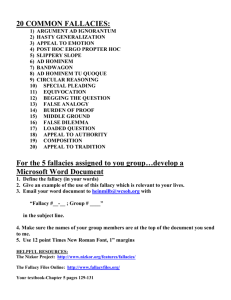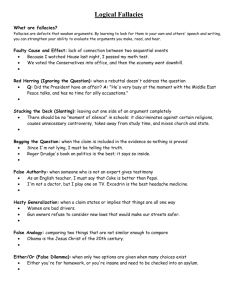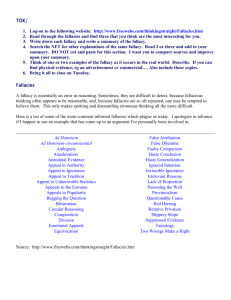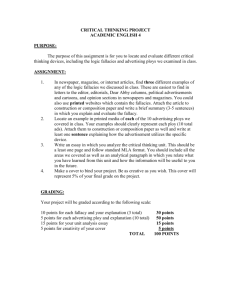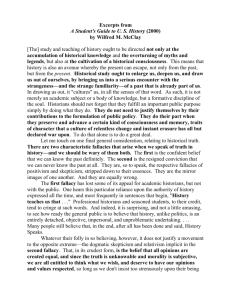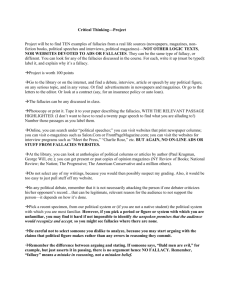Logical Fallacy Assignment
advertisement
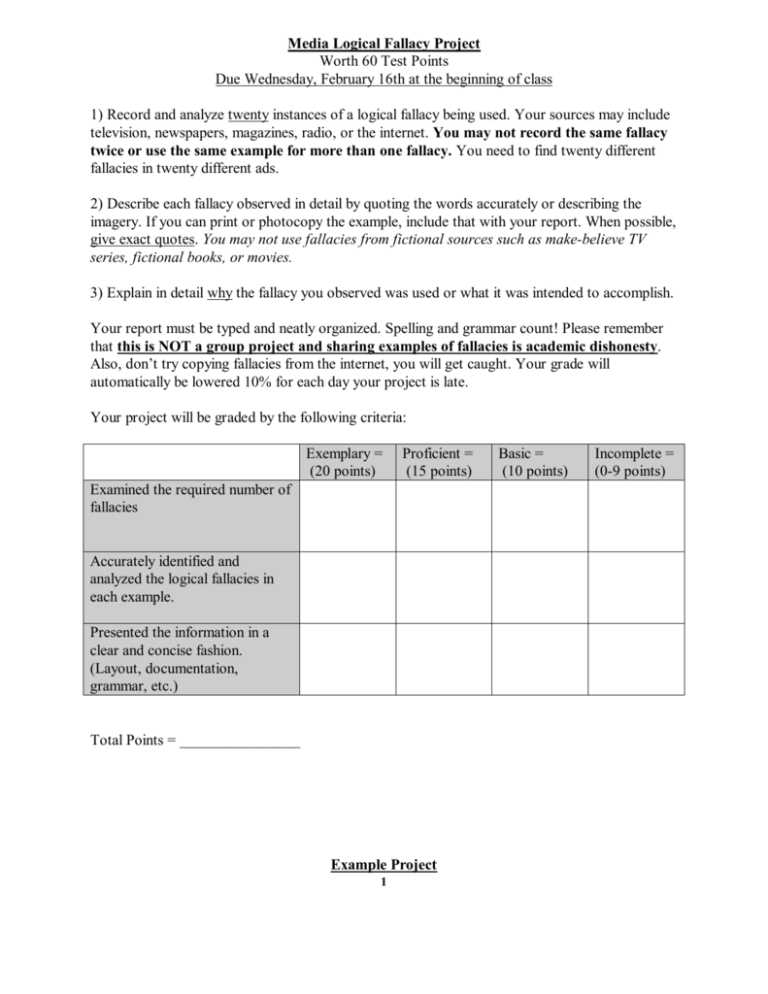
Media Logical Fallacy Project Worth 60 Test Points Due Wednesday, February 16th at the beginning of class 1) Record and analyze twenty instances of a logical fallacy being used. Your sources may include television, newspapers, magazines, radio, or the internet. You may not record the same fallacy twice or use the same example for more than one fallacy. You need to find twenty different fallacies in twenty different ads. 2) Describe each fallacy observed in detail by quoting the words accurately or describing the imagery. If you can print or photocopy the example, include that with your report. When possible, give exact quotes. You may not use fallacies from fictional sources such as make-believe TV series, fictional books, or movies. 3) Explain in detail why the fallacy you observed was used or what it was intended to accomplish. Your report must be typed and neatly organized. Spelling and grammar count! Please remember that this is NOT a group project and sharing examples of fallacies is academic dishonesty. Also, don’t try copying fallacies from the internet, you will get caught. Your grade will automatically be lowered 10% for each day your project is late. Your project will be graded by the following criteria: Exemplary = (20 points) Proficient = (15 points) Examined the required number of fallacies Accurately identified and analyzed the logical fallacies in each example. Presented the information in a clear and concise fashion. (Layout, documentation, grammar, etc.) Total Points = ________________ Example Project 1 Basic = (10 points) Incomplete = (0-9 points) 1) Symbolism: During the Republicrat debate, political candidate X wore an American flag pin on his lapel. For many people this symbol represents patriotism, American values, tradition, nationalism, and democracy. Candidate X wants voters to associate these images with him and with his campaign in the hopes that it will help win more votes. 2) Simple Solutions: While on CNN’s Larry King Live show on Monday, October 29, 2010, candidate Y said, “All we need is to do is cut the deficit in half, and the American economy will get back on track.” This solution avoids the complexities of a global economy and a wide range of economic factors influencing our society. Our economy is also affected by the current mortgage crisis, the war in Afghanistan, trade deficits, and a weak dollar. Candidate Y wants voters to think that she has a good plan for fixing the economy, and that this plan is easily achievable, therefore, she is a good choice for president. 3) Warm and Fuzzy: While campaigning in Iowa, and as seen on Fox News Tuesday, October 30, 2010, Candidate X kissed a baby in the crowd while walking to the podium to deliver a speech. This is a sentimental image designed to evoke a warm response from the audience and to represent family values. Candidate X wants this warm response to be associated with his campaign and to make him seem like a kind and compassionate person who is wholesome and respects children, thereby winning more votes. 4) Flattery: Candidate Y stated on his website, www.voteforme.com, “Americans are strong, hard-working, honest people, and I am proud of the America that I see as I travel across this great land.” This is an attempt to make people feel good about themselves and therefore feel good about voting for Candidate Y. 5) Sex Appeal: The attached Coke ad shows a thin, happy, beautiful girl drinking from a can of Coke while surrounded by attractive men who are trying to flirt with her. The ad is using sex appeal to catch our attention and to convince girls that by drinking a sugary soda they too can be beautiful, thin and catch a lot of good looking guys. 6) Fear: While listening to Classical Radio Station 99.5 around 8:30 am on Wednesday, October 31, I heard an ad from Tax Busters which said, “We can help you resolve late tax payments before the IRS catches you. The IRS knows who you are and they will find you! There is no hiding from the IRS, so call us today before it is too late. Delaying puts you at risk for fines and even jail!” This ad is trying to scare people into hiring Tax Busters to help them resolve tax issues. In truth, very few people ever go to jail for tax evasion. Although paying your taxes on time is important and allows you to avoid penalty payments, jail is highly unlikely. This is a scare tactic to get people to spend money on tax advice they may not need. 7) Testimonial: In the attached Buick magazine ad, Tiger Woods is seen leaning against a Buick SUV. Although he is a great golfer, Tiger Woods is not necessarily an expert in automobiles. Because people trust those that they admire, the ad is trying to lure people who like Tiger into buying a Buick. 2
